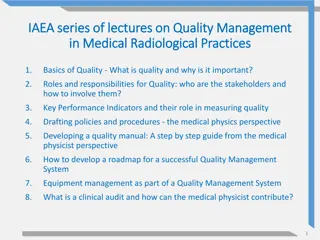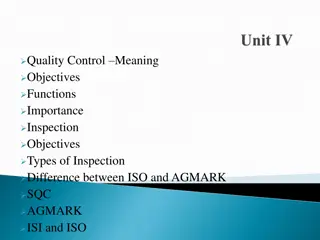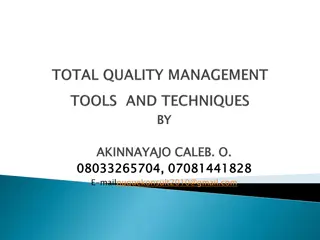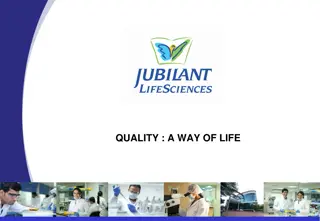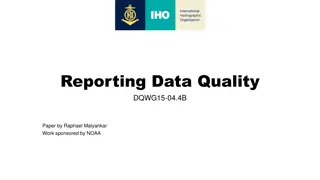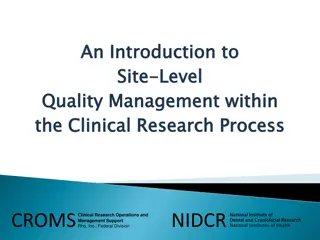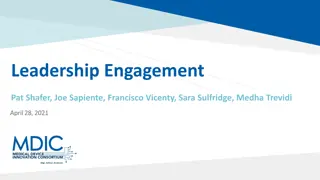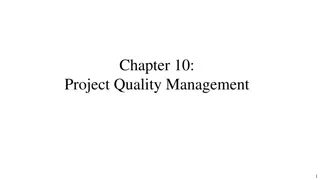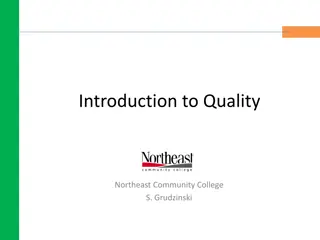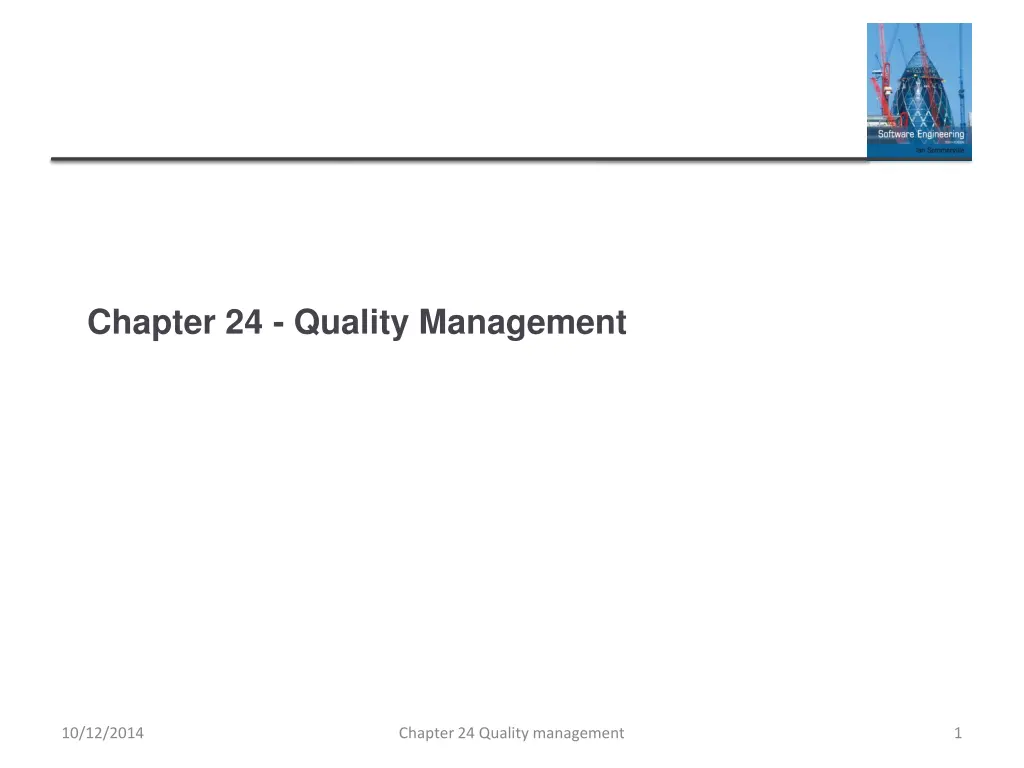
Software Quality Management and Agile Development
Explore the importance of quality management in software development, including topics like software standards, reviews, quality planning, and quality assurance. Learn how quality management ensures the required level of quality in software products through independent checks and process adherence.
Download Presentation

Please find below an Image/Link to download the presentation.
The content on the website is provided AS IS for your information and personal use only. It may not be sold, licensed, or shared on other websites without obtaining consent from the author. If you encounter any issues during the download, it is possible that the publisher has removed the file from their server.
You are allowed to download the files provided on this website for personal or commercial use, subject to the condition that they are used lawfully. All files are the property of their respective owners.
The content on the website is provided AS IS for your information and personal use only. It may not be sold, licensed, or shared on other websites without obtaining consent from the author.
E N D
Presentation Transcript
Chapter 24 - Quality Management 10/12/2014 Chapter 24 Quality management 1
Topics covered Software quality Software standards Reviews and inspections Quality management and agile development Software measurement 10/12/2014 Chapter 24 Quality management 2
Software quality management Concerned with ensuring that the required level of quality is achieved in a software product. Three principal concerns: At the organizational level, quality management is concerned with establishing a framework of organizational processes and standards that will lead to high-quality software. At the project level, quality management involves the application of specific quality processes and checking that these planned processes have been followed. At the project level, quality management is also concerned with establishing a quality plan for a project. The quality plan should set out the quality goals for the project and define what processes and standards are to be used. 10/12/2014 Chapter 24 Quality management 3
Quality management activities Quality management provides an independent check on the software development process. The quality management process checks the project deliverables to ensure that they are consistent with organizational standards and goals The quality team should be independent from the development team so that they can take an objective view of the software. This allows them to report on software quality without being influenced by software development issues. 10/12/2014 Chapter 24 Quality management 4
Quality management and software development 10/12/2014 Chapter 24 Quality management 5
Quality planning A quality plan sets out the desired product qualities and how these are assessed and defines the most significant quality attributes. The quality plan should define the quality assessment process. It should set out which organisational standards should be applied and, where necessary, define new standards to be used. 10/12/2014 Chapter 24 Quality management 6
Quality plans Quality plan structure Product introduction; Product plans; Process descriptions; Quality goals; Risks and risk management. Quality plans should be short, succinct documents If they are too long, no-one will read them. 10/12/2014 Chapter 24 Quality management 7
Scope of quality management Quality management is particularly important for large, complex systems. The quality documentation is a record of progress and supports continuity of development as the development team changes. For smaller systems, quality management needs less documentation and should focus on establishing a quality culture. Techniques have to evolve when agile development is used. 10/12/2014 Chapter 24 Quality management 8
Software quality 10/12/2014 Chapter 24 Quality management 9
Software quality Quality, simplistically, means that a product should meet its specification. This is problematical for software systems There is a tension between customer quality requirements (efficiency, reliability, etc.) and developer quality requirements (maintainability, reusability, etc.); Some quality requirements are difficult to specify in an unambiguous way; Software specifications are usually incomplete and often inconsistent. The focus may be fitness for purpose rather than specification conformance. 10/12/2014 Chapter 24 Quality management 10
Software fitness for purpose Has the software been properly tested? Is the software sufficiently dependable to be put into use? Is the performance of the software acceptable for normal use? Is the software usable? Is the software well-structured and understandable? Have programming and documentation standards been followed in the development process? 10/12/2014 Chapter 24 Quality management 11
Non-functional characteristics The subjective quality of a software system is largely based on its non-functional characteristics. This reflects practical user experience if the software s functionality is not what is expected, then users will often just work around this and find other ways to do what they want to do. However, if the software is unreliable or too slow, then it is practically impossible for them to achieve their goals. 10/12/2014 Chapter 24 Quality management 12
Software quality attributes Safety Understandability Portability Security Testability Usability Reliability Adaptability Reusability Resilience Modularity Efficiency Robustness Complexity Learnability 10/12/2014 Chapter 24 Quality management 13
Quality conflicts It is not possible for any system to be optimized for all of these attributes for example, improving robustness may lead to loss of performance. The quality plan should therefore define the most important quality attributes for the software that is being developed. The plan should also include a definition of the quality assessment process, an agreed way of assessing whether some quality, such as maintainability or robustness, is present in the product. 10/12/2014 Chapter 24 Quality management 14
Process and product quality The quality of a developed product is influenced by the quality of the production process. This is important in software development as some product quality attributes are hard to assess. However, there is a very complex and poorly understood relationship between software processes and product quality. The application of individual skills and experience is particularly important in software development; External factors such as the novelty of an application or the need for an accelerated development schedule may impair product quality. 10/12/2014 Chapter 24 Quality management 15
Process-based quality 10/12/2014 Chapter 24 Quality management 16
Quality culture Quality managers should aim to develop a quality culture where everyone responsible for software development is committed to achieving a high level of product quality. They should encourage teams to take responsibility for the quality of their work and to develop new approaches to quality improvement. They should support people who are interested in the intangible aspects of quality and encourage professional behavior in all team members. 10/12/2014 Chapter 24 Quality management 17
Software standards 10/12/2014 Chapter 24 Quality management 18
Software standards Standards define the required attributes of a product or process. They play an important role in quality management. Standards may be international, national, organizational or project standards. 10/12/2014 Chapter 24 Quality management 19
Importance of standards Encapsulation of best practice- avoids repetition of past mistakes. They are a framework for defining what quality means in a particular setting i.e. that organization s view of quality. They provide continuity - new staff can understand the organisation by understanding the standards that are used. 10/12/2014 Chapter 24 Quality management 20
Product and process standards Product standards Apply to the software product being developed. They include document standards, such as the structure of requirements documents, documentation standards, such as a standard comment header for an object class definition, and coding standards, which define how a programming language should be used. Process standards These define the processes that should be followed during software development. Process standards may include definitions of specification, design and validation processes, process support tools and a description of the documents that should be written during these processes. 10/12/2014 Chapter 24 Quality management 21
Product and process standards Product standards Process standards Design review form Design review conduct Requirements document structure Method header format Submission of new code for system building Version release process Java programming style Project plan approval process Project plan format Change control process Change request form Test recording process 10/12/2014 Chapter 24 Quality management 22
Problems with standards They may not be seen as relevant and up-to-date by software engineers. They often involve too much bureaucratic form filling. If they are unsupported by software tools, tedious form filling work is often involved to maintain the documentation associated with the standards. 10/12/2014 Chapter 24 Quality management 23
Standards development Involve practitioners in development. Engineers should understand the rationale underlying a standard. Review standards and their usage regularly. Standards can quickly become outdated and this reduces their credibility amongst practitioners. Detailed standards should have specialized tool support. Excessive clerical work is the most significant complaint against standards. Web-based forms are not good enough. 10/12/2014 Chapter 24 Quality management 24
ISO 9001 standards framework An international set of standards that can be used as a basis for developing quality management systems. ISO 9001, the most general of these standards, applies to organizations that design, develop and maintain products, including software. The ISO 9001 standard is a framework for developing software standards. It sets out general quality principles, describes quality processes in general and lays out the organizational standards and procedures that should be defined. These should be documented in an organizational quality manual. 10/12/2014 Chapter 24 Quality management 25
ISO 9001 core processes 10/12/2014 Chapter 24 Quality management 26
ISO 9001 and quality management 10/12/2014 Chapter 24 Quality management 27
ISO 9001 certification Quality standards and procedures should be documented in an organisational quality manual. An external body may certify that an organisation s quality manual conforms to ISO 9000 standards. Some customers require suppliers to be ISO 9000 certified although the need for flexibility here is increasingly recognised. 10/12/2014 Chapter 24 Quality management 28
Software quality and ISO9001 The ISO 9001 certification is inadequate because it defines quality to be the conformance to standards. It takes no account of quality as experienced by users of the software. For example, a company could define test coverage standards specifying that all methods in objects must be called at least once. Unfortunately, this standard can be met by incomplete software testing that does not include tests with different method parameters. So long as the defined testing procedures are followed and test records maintained, the company could be ISO 9001 certified. 10/12/2014 Chapter 24 Quality management 29
Reviews and inspections 10/12/2014 Chapter 24 Quality management 30
Reviews and inspections A group examines part or all of a process or system and its documentation to find potential problems. Software or documents may be 'signed off' at a review which signifies that progress to the next development stage has been approved by management. There are different types of review with different objectives Inspections for defect removal (product); Reviews for progress assessment (product and process); Quality reviews (product and standards). 10/12/2014 Chapter 24 Quality management 31
Quality reviews A group of people carefully examine part or all of a software system and its associated documentation. Code, designs, specifications, test plans, standards, etc. can all be reviewed. Software or documents may be 'signed off' at a review which signifies that progress to the next development stage has been approved by management. 10/12/2014 Chapter 24 Quality management 32
Phases in the review process Pre-review activities Pre-review activities are concerned with review planning and review preparation The review meeting During the review meeting, an author of the document or program being reviewed should walk through the document with the review team. Post-review activities These address the problems and issues that have been raised during the review meeting. 10/12/2014 Chapter 24 Quality management 33
The software review process 10/12/2014 Chapter 24 Quality management 34
Distributed reviews The processes suggested for reviews assume that the review team has a face-to-face meeting to discuss the software or documents that they are reviewing. However, project teams are now often distributed, sometimes across countries or continents, so it is impractical for team members to meet face to face. Remote reviewing can be supported using shared documents where each review team member can annotate the document with their comments. 10/12/2014 Chapter 24 Quality management 35
Program inspections These are peer reviews where engineers examine the source of a system with the aim of discovering anomalies and defects. Inspections do not require execution of a system so may be used before implementation. They may be applied to any representation of the system (requirements, design,configuration data, test data, etc.). They have been shown to be an effective technique for discovering program errors. 10/12/2014 Chapter 24 Quality management 36
Inspection checklists Checklist of common errors should be used to drive the inspection. Error checklists are programming language dependent and reflect the characteristic errors that are likely to arise in the language. In general, the 'weaker' the type checking, the larger the checklist. Examples: Initialisation, Constant naming, loop termination, array bounds, etc. 10/12/2014 Chapter 24 Quality management 37
An inspection checklist (a) Fault class Data faults Inspection check Are all program variables initialized before their values are used? Have all constants been named? Should the upper bound of arrays be equal to the size of the array or Size -1? If character strings are used, is a delimiter explicitly assigned? Is there any possibility of buffer overflow? For each conditional statement, is the condition correct? Is each loop certain to terminate? Are compound statements correctly bracketed? In case statements, are all possible cases accounted for? If a break is required after each case in case statements, has it been included? Are all input variables used? Are all output variables assigned a value before they are output? Can unexpected inputs cause corruption? Control faults Input/output faults 10/12/2014 Chapter 24 Quality management 38
An inspection checklist (b) Fault class Interface faults Inspection check Do all function and method calls have the correct number of parameters? Do formal and actual parameter types match? Are the parameters in the right order? If components access shared memory, do they have the same model of the shared memory structure? If a linked structure is modified, have all links been correctly reassigned? If dynamic storage is used, has space been allocated correctly? Is space explicitly deallocated after it is no longer required? Have all possible error conditions been taken into account? Storage faults management Exception faults management 10/12/2014 Chapter 24 Quality management 39
Quality management and agile development 10/12/2014 Chapter 24 Quality management 40
Quality management and agile development Quality management in agile development is informal rather than document-based. It relies on establishing a quality culture, where all team members feel responsible for software quality and take actions to ensure that quality is maintained. The agile community is fundamentally opposed to what it sees as the bureaucratic overheads of standards-based approaches and quality processes as embodied in ISO 9001. 10/12/2014 Chapter 24 Quality management 41
Shared good practice Check before check-in Programmers are responsible for organizing their own code reviews with other team members before the code is checked in to the build system. Never break the build Team members should not check in code that causes the system to fail. Developers have to test their code changes against the whole system and be confident that these work as expected. Fix problems when you see them If a programmer discovers problems or obscurities in code developed by someone else, they can fix these directly rather than referring them back to the original developer. 10/12/2014 Chapter 24 Quality management 42
Reviews and agile methods The review process in agile software development is usually informal. In Scrum,, there is a review meeting after each iteration of the software has been completed (a sprint review), where quality issues and problems may be discussed. In Extreme Programming, pair programming ensures that code is constantly being examined and reviewed by another team member. 10/12/2014 Chapter 24 Quality management 43
Pair programming This is an approach where 2 people are responsible for code development and work together to achieve this. Code developed by an individual is therefore constantly being examined and reviewed by another team member. Pair programming leads to a deep knowledge of a program, as both programmers have to understand the program in detail to continue development. This depth of knowledge is difficult to achieve in inspection processes and pair programming can find bugs that would not be discovered in formal inspections. 10/12/2014 Chapter 24 Quality management 44
Pair programming weaknesses Mutual misunderstandings Both members of a pair may make the same mistake in understanding the system requirements. Discussions may reinforce these errors. Pair reputation Pairs may be reluctant to look for errors because they do not want to slow down the progress of the project. Working relationships The pair s ability to discover defects is likely to be compromised by their close working relationship that often leads to reluctance to criticize work partners. 10/12/2014 Chapter 24 Quality management 45
Agile QM and large systems When a large system is being developed for an external customer, agile approaches to quality management with minimal documentation may be impractical. If the customer is a large company, it may have its own quality management processes and may expect the software development company to report on progress in a way that is compatible with them. Where there are several geographically distributed teams involved in development, perhaps from different companies, then informal communications may be impractical. For long-lifetime systems, the team involved in development will changeWithout documentation, new team members may find it impossible to understand development. 10/12/2014 Chapter 24 Quality management 46
Software measurement 10/12/2014 Chapter 24 Quality management 47
Software measurement Software measurement is concerned with deriving a numeric value for an attribute of a software product or process. This allows for objective comparisons between techniques and processes. Although some companies have introduced measurement programmes, most organisations still don t make systematic use of software measurement. There are few established standards in this area. 10/12/2014 Chapter 24 Quality management 48
Software metric Any type of measurement which relates to a software system, process or related documentation Lines of code in a program, the Fog index, number of person- days required to develop a component. Allow the software and the software process to be quantified. May be used to predict product attributes or to control the software process. Product metrics can be used for general predictions or to identify anomalous components. 10/12/2014 Chapter 24 Quality management 49
Types of process metric The time taken for a particular process to be completed This can be the total time devoted to the process, calendar time, the time spent on the process by particular engineers, and so on. The resources required for a particular process Resources might include total effort in person-days, travel costs or computer resources. The number of occurrences of a particular event Examples of events that might be monitored include the number of defects discovered during code inspection, the number of requirements changes requested, the number of bug reports in a delivered system and the average number of lines of code modified in response to a requirements change. 10/12/2014 Chapter 24 Quality management 50


